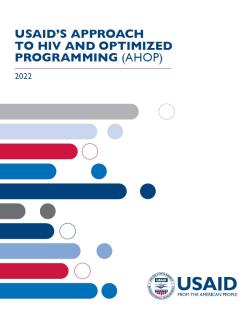USAID has led in the global fight against HIV since the mid-1990s and has been a key implementing agency of the President’s Emergency Plan for AIDS Relief (PEPFAR) since it was established by President George W. Bush in 2003. USAID delivers lifesaving HIV treatment and prevention services in over 50 countries and invests in strengthening countries’ health systems to reach HIV epidemic control. After nearly 20 years of PEPFAR, and as more countries reach and sustain HIV epidemic control, the global HIV response model and USAID’s programming must shift from an emergency response to an institutionalized and sustained HIV epidemic control approach.
In support of the new PEPFAR five-year strategy, the USAID Approach to HIV and Optimized Programming (AHOP) is a framework for USAID to employ “whole of Agency” assets, and efficient, measured, and simplified programmatic approaches to ensure resilient and country-led approaches to the HIV response. Assets include comprehensive health programming – malaria, tuberculosis, reproductive health and family planning, maternal and child health, nutrition, and global health security. USAID also holds vibrant and established education, economic growth, democracy and governance, humanitarian assistance, and human rights portfolios. Combined, these assets will ensure long-term sustainability and success in the decades-long fight to control the HIV epidemic.
The AHOP defines five critical pathways through which USAID will assist countries sustaining epidemic control and accelerate progress in those that have not yet achieved the 95-95-95 goals. Each pathway outlines planned results and time-bound milestones.
- Simplified service delivery models that address clients’ holistic needs and seek opportunities to integrate with and leverage other health programming;
- Adolescent and youth resilience, which recognizes the importance of the public and private sectors to build adolescent and youth resilience to prevent HIV and sustain HIV epidemic control, and ensure youth can fully contribute to a country’s overall economic health and development;
- A locally-led and managed HIV response, which recognizes the importance of engaging the full continuum of public/private health sector partners for well-governed and resilient health systems;
- Client-centered supply chain solutions which maximize product availability, choice, quality, affordability and strengthen host government oversight, management, supply chain resilience and security; and
- Pandemic readiness, response, and resilience to future shocks.
In this next phase of PEPFAR, USAID will channel its multi-sectoral expertise through the AHOP Five Critical Pathways to meet HIV and broader health and development goals, including prevention, detection, and response to COVID-19 and other emerging infectious diseases. The AHOP provides a framework to guide USAID program managers and partners to strategically plan and implement programs in the context of HIV epidemic control, and ensure the program sustains the nearly 19 million individuals currently on lifesaving ART through PEPFAR.

